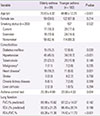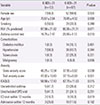Abstract
Purpose
The prevalence of asthma among the elderly has increased in the aging society. However, limited studies have been conducted regarding the characteristics of elderly asthmatics. In this study, we aimed to evaluate control of asthma, comorbidities, depression and anxiety state, and quality of life in elderly asthmatics.
Methods
A total of 281 patients who were diagnosed with asthma and treated more than 1 year were enrolled. We evaluated not only clinical characteristics, but also depression, anxiety, and quality of life by using the Beck Depression Inventory-Korean version (K-BDI), the State-Trait Anxiety Inventory, and Korean asthma quality of life (KAQLQ), respectively.
Results
Diabetes mellitus (15.2% vs. 6.6%, P=0.020), hypertension (45.5% vs. 18.7%, P<0.001), and heart disease (18.2% vs. 6.0%, P=0.001) were more prevalent comorbidities in elderly asthmatics than young asthmatics. However, there were no differences in the degree of asthma control and lung function between elderly and young asthmatics. K-BDI scores were higher (12.32 vs. 10.99, P=0.020) and KAQLQ was lower (66.60 vs. 68.83, P=0.046) in the elderly asthmatics than in the young asthmatics. Moreover, the low score of asthma control test was significantly associated with depression in the elderly asthmatics (P=0.01).
Figures and Tables
Table 1
Comparison between the elderly asthma patients and the younger asthma patients

Values are presented as mean mean±standard deviation or number (%).
FVC, forced vital capacity; FEV1, forced expiratory volume in 1 second.
*Malignancy (total, elderly asthma vs. younger asthma): breast cancer (6, 1 vs. 5), esophageal cancer (1, 0 vs. 1), lung cancer (2, 1 vs. 1), papillary thyroid carcinoma (3, 3 vs. 0), rectal cancer (1, 1 vs. 0), and stomach cancer (2, 1 vs. 1). †Heart disease: angina pectoris, myocardial infarction, heart failure, atrial fibrillation, and valvular heart disease.
Table 2
Depression, anxiety, quality of life, and unexpected hospital use in the elderly asthma patients and the younger asthma patients

Table 3
Depression, anxiety, quality of life, and unexpected hospital use according to the degree of control in the elderly asthma patients

References
1. Centers for Disease Control and Prevention (CDC). Vital signs: asthma prevalence, disease characteristics, and self-management education: United States, 2001-2009. MMWR Morb Mortal Wkly Rep. 2011; 60:547–552.
2. Cho SH, Park HW, Rosenberg DM. The current status of asthma in Korea. J Korean Med Sci. 2006; 21:181–187.

3. Park HS, Choi GS, Cho JS, Kim YY. Epidemiology and current status of allergic rhinitis, asthma, and associated allergic diseases in Korea: ARIA Asia-Pacific workshop report. Asian Pac J Allergy Immunol. 2009; 27:167–171.
4. Lee YH, Yoon SJ, Kim EJ, Kim YA, Seo HY, Oh IH. Economic burden of asthma in Korea. Allergy Asthma Proc. 2011; 32:35–40.

5. Kim SY, Jung JY, Park MS, Kang YA, Kim EY, Kim SK, et al. Increased prevalence of self-reported asthma among Korean adults: an analysis of KNHANES I and IV data. Lung. 2013; 191:281–288.

6. Hong SJ, Ahn KM, Lee SY, Kim KE. The prevalences of asthma and allergic diseases in Korean children. Pediatr Allergy Respir Dis. 2008; 18:15–25.

7. Kim YK, Kim SH, Tak YJ, Jee YK, Lee BJ, Kim SH, et al. High prevalence of current asthma and active smoking effect among the elderly. Clin Exp Allergy. 2002; 32:1706–1712.

8. Oraka E, Kim HJ, King ME, Callahan DB. Asthma prevalence among US elderly by age groups: age still matters. J Asthma. 2012; 49:593–599.

9. Kim DI, Kwon HS, Song WJ, Lee SM, Kim SH, Sohn SW, et al. Characteristics of the elderly asthma. Korean J Asthma Allergy Clin Immunol. 2008; 28:98–104.
10. Hanania NA, King MJ, Braman SS, Saltoun C, Wise RA, Enright P, et al. Asthma in the elderly: Current understanding and future research needs: a report of a National Institute on Aging (NIA) workshop. J Allergy Clin Immunol. 2011; 128:3 Suppl. S4–S24.
11. Hwang EK, Jin HJ, Nam YH, Shin YS, Ye YM, Nahm DH, et al. The predictors of poorly controlled asthma in elderly. Allergy Asthma Immunol Res. 2012; 4:270–276.

12. Di Marco F, Verga M, Santus P, Giovannelli F, Busatto P, Neri M, et al. Close correlation between anxiety, depression, and asthma control. Respir Med. 2010; 104:22–28.

13. de Miguel Diez J, Hernandez Barrera V, Puente Maestu L, Carrasco Garrido P, Gomez Garcia T, Jimenez Garcia R. Psychiatric comorbidity in asthma patients. Associated factors. J Asthma. 2011; 48:253–258.

14. The Global Initiative for Asthma. GINA Report, Global strategy for asthma management and prevention. Updated Dec. 2011 [Internet]. The Global Initiative for Asthma;c2011. cited 2012 Feb 13. Available from: http://www.ginasthma.org/guidelines-gina-report-global-strategy-for-asthma.html.
15. Crapo RO, Casaburi R, Coates AL, Enright PL, Hankinson JL, Irvin CG, et al. Guidelines for methacholine and exercise challenge testing-1999. This official statement of the American Thoracic Society was adopted by the ATS Board of Directors, July 1999. Am J Respir Crit Care Med. 2000; 161:309–329.
16. Schatz M, Sorkness CA, Li JT, Marcus P, Murray JJ, Nathan RA, et al. Asthma control test: reliability, validity, and responsiveness in patients not previously followed by asthma specialists. J Allergy Clin Immunol. 2006; 117:549–556.

17. Rhee MK, Lee YH, Park SH, Sohn CH, Chung YC, Hong SK, et al. A standardization study of Beck Depression Inventory I-Korean version (K-BDI): reliability and factor analysis. Korean J Psychopathol. 1995; 4:77–95.
18. Ryu YJ, Chun EM, Sim YS, Lee JH. Depression and anxiety in outpatients with chronic obstructive pulmonary disease. Tuberc Respir Dis. 2007; 62:11–18.

19. Spielberger CD, Gorsuch RL, Lushene RE. Manual for the state-trait anxiety inventory (Form X). Palo Alto, CA: Consulting Psychologists Press;1970.
20. Park JW, Cho YS, Lee SY, Nahm DH, Kim YK, Kim DK, et al. Multi-center study for the utilization of quality of life questionnaire for adult Korean asthmatics (QLQAKA). J Asthma Allergy Clin Immunol. 2000; 20:467–480.
22. Smith AM, Villareal M, Bernstein DI, Swikert DJ. Asthma in the elderly: risk factors and impact on physical function. Ann Allergy Asthma Immunol. 2012; 108:305–310.

23. Park J, Kim TB, Joo H, Lee JS, Lee SD, Oh YM. Diseases concomitant with asthma in middle-aged and elderly subjects in Korea: a population-based study. Allergy Asthma Immunol Res. 2013; 5:16–25.

25. Loerbroks A, Herr RM, Subramanian S, Bosch JA. The association of asthma and wheezing with major depressive episodes: an analysis of 245 727 women and men from 57 countries. Int J Epidemiol. 2012; 41:1436–1444.

26. Urrutia I, Aguirre U, Pascual S, Esteban C, Ballaz A, Arrizubieta I, et al. Impact of anxiety and depression on disease control and quality of life in asthma patients. J Asthma. 2012; 49:201–208.

27. Krauskopf KA, Sofianou A, Goel MS, Wolf MS, Wilson EA, Martynenko ME, et al. Depressive symptoms, low adherence, and poor asthma outcomes in the elderly. J Asthma. 2013; 50:260–266.

28. Bellia V, Pedone C, Catalano F, Zito A, Davi E, Palange S, et al. Asthma in the elderly: mortality rate and associated risk factors for mortality. Chest. 2007; 132:1175–1182.
29. Van Lieshout RJ, Bienenstock J, MacQueen GM. A review of candidate pathways underlying the association between asthma and major depressive disorder. Psychosom Med. 2009; 71:187–195.

30. Du YJ, Li B, Zhang HY, Cao YX, Duan XH, Gong WY, et al. Airway inflammation and hypothalamic-pituitary-adrenal axis activity in asthmatic adults with depression. J Asthma. 2013; 50:274–281.





 PDF
PDF ePub
ePub Citation
Citation Print
Print



 XML Download
XML Download